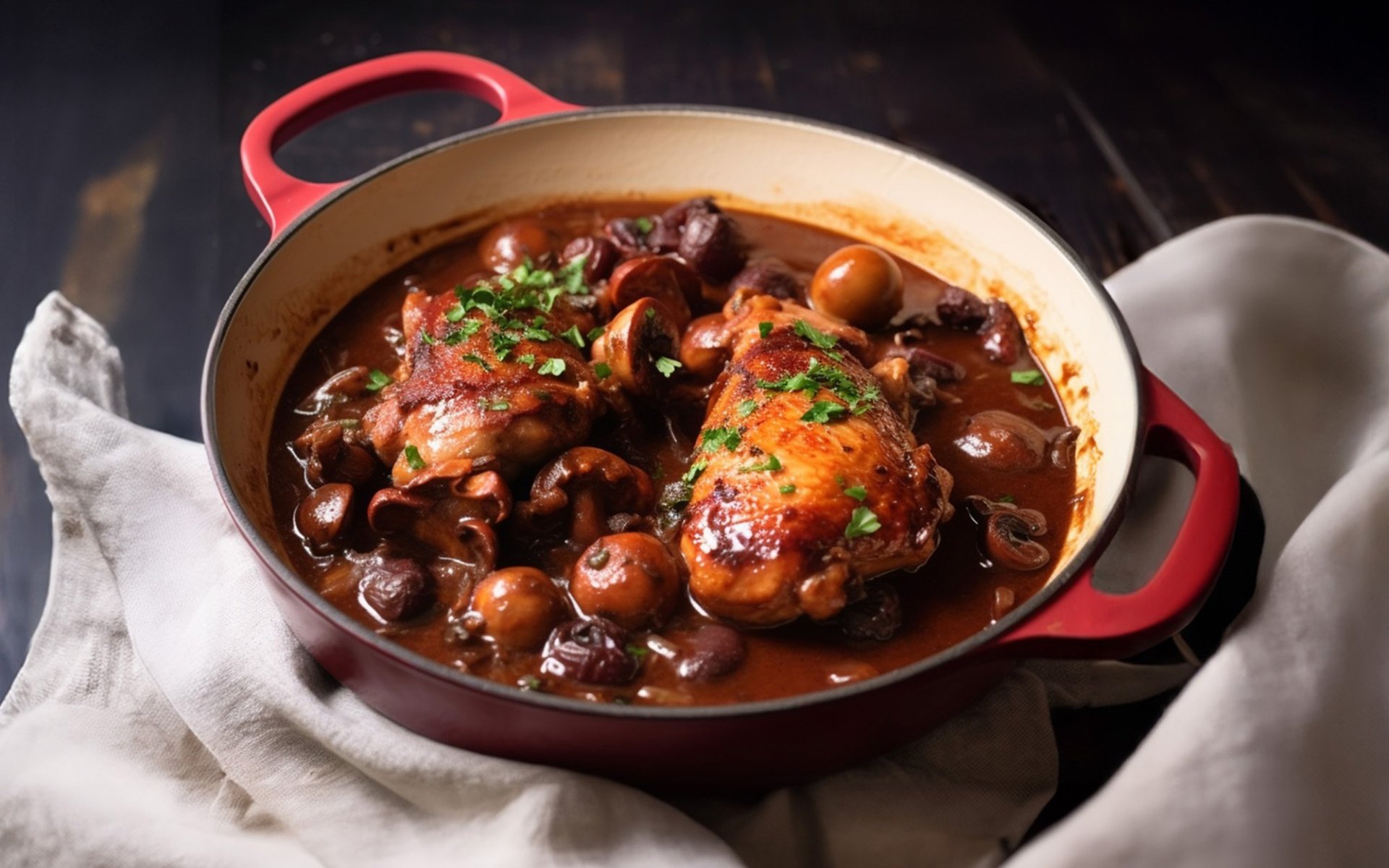Coq au Vin

When discussing French cuisine, numerous dishes come to mind that embody its elegance and unique culinary culture. Among them is Coq au Vin, a chicken and red wine stew that not only offers profound flavors but also carries a fascinating historical narrative.
What is Coq au Vin? Why Rooster?
Coq au Vin is a French term that literally translates to rooster in wine, clearly indicating the main ingredient of this dish. The word Coq specifically refers to a mature male chicken or rooster. The traditional reason for using a rooster in this dish is that its meat is tougher and denser than that of a hen, requiring a longer and more meticulous braising process to achieve tenderness and allow it to fully absorb the rich flavors of the sauce.
The Legend of Coq au Vin: A Challenge Between a Rooster and a Roman Emperor
The origins of Coq au Vin are tied to a captivating story dating back to 52 BC, during the Roman Empire's war against the Gauls (Gaulois), ancient inhabitants of France. Legend has it that Vercingétorix, the chieftain of the Arverne tribe, one of the Gallic tribes, rallied his army to resist and impede the invasion of Julius Caesar, the leader of the Roman Empire.
As a gesture of defiance and unwillingness to yield, Vercingétorix sent a rooster (Coq) to Julius Caesar. The rooster was a symbol representing the bravery, defiance, and indomitable spirit of the Gallic tribes. Upon receiving the rooster, Julius Caesar demonstrated his power and wit. He invited the Arverne chieftain to dine with him and served him that very rooster, slow-braised in red wine. This act was a reciprocal challenge, signaling that Caesar, too, would not surrender and could easily conquer the symbol of Gallic courage.
Ultimately, the protracted Gallic Wars concluded with Julius Caesar's victory at Alesia, the last stronghold of the Gallic tribes (now part of France). It is said that the Gauls' humiliating and decisive defeat was likened to their symbol of bravery, the rooster, being slowly cooked in red wine by the Roman army, symbolizing their complete subjugation.
Coq au Vin in French Culinary Culture and Its Global Journey
Over time, Coq au Vin began to emerge in French culinary culture, gaining widespread popularity in rural areas. Roosters were readily available on farms, as farmers typically kept hens for egg production rather than consumption. Despite its local popularity, a definitive traditional French Coq au Vin recipe was not formally recorded in cookbooks until the 20th century. However, similar recipes, such as "Poulet au vin blanc" (chicken in white wine), appeared in English cookbooks like Cookery for English Households in 1864.
However, in the mid-20th century, Coq au Vin achieved true international acclaim. The traditional red wine-based recipe was featured in the highly influential cookbook Mastering the Art of French Cooking, co-authored by Julia Child, Louisette Bertholle, and Simone Beck in 1961. Furthermore, Julia Child popularized the dish on her acclaimed American television show, The French Chef, which she created and hosted. Through Julia Child's influence, Coq au Vin became widely known in American kitchens and subsequently, across the globe.
Diversity and Cultural Significance
As Coq au Vin gained popularity in diverse regions and culinary cultures, numerous variations emerged to cater to different tastes and preferences. For instance, in the Provence region of southern France, tomatoes and various herbs are often added, lending the dish a fresher, more vibrant Mediterranean influence.
Beyond its culinary appeal, Coq au Vin holds significant cultural importance as a symbol of French gastronomy. With its meticulous preparation techniques and use of carefully selected ingredients, this dish transcended its humble peasant origins to become a beloved delicacy among both the middle and upper classes in France. The French often enjoy Coq au Vin accompanied by mashed potatoes, which provides a satisfying complement to the rich sauce.
Today, Coq au Vin continues to enjoy enduring popularity and has evolved with the times. The chicken used in the dish is not necessarily limited to roosters anymore. If other types of chicken are used, the dish may be referred to differently, such as Poulet (poulet) for chicken that has been slaughtered before reaching full maturity (where sex cannot be determined), and Poule (poule) for a hen. If you wish to create this classic Coq au Vin or other exquisite French dishes, Rimping Supermarket offers a comprehensive selection of high-quality ingredients for your culinary endeavors.


